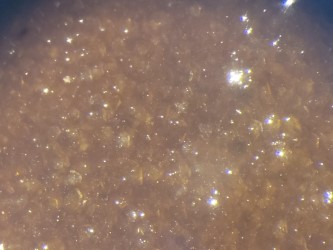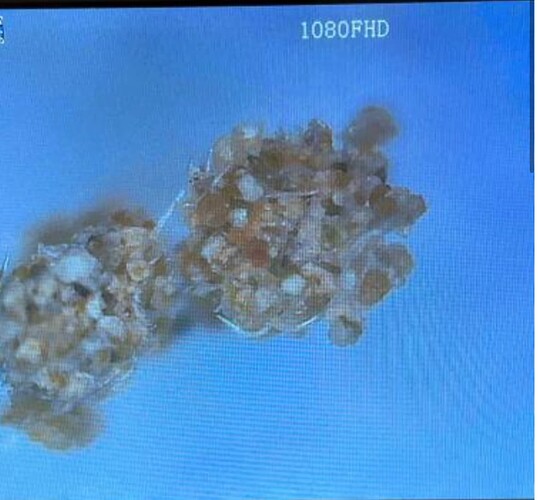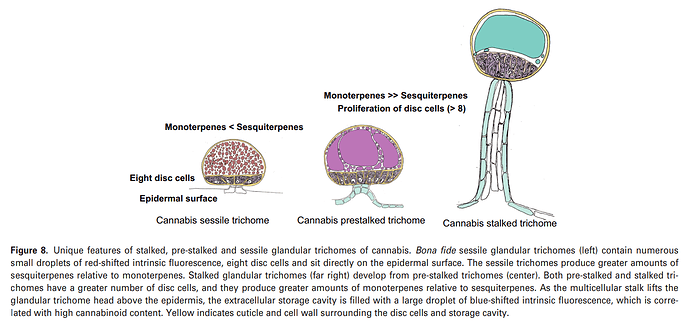Water can be a solvent but in this instance the trichrome heads are suspended in water, not dissolved
But certainly some terpenes are?
I burned some main stems en sticks from a very high thc strain, in a little survival burner last year.
The main stems didnt fit in, heat and gravity did melt some oil out the stem.
My girl was like, wtf is that:joy:![]() so I went to look at what she pointed at. I was like fuck, thats extract:joy:
so I went to look at what she pointed at. I was like fuck, thats extract:joy:
It looked, tasted, smelled exactly like a extract. Specifically like the first bho I did years ago, wich was purged way too hot😂
So much energy lol
I think this is what the majority of consumers are thinking when they see/use the term “solventless”.
This thread is hilarious imo.
As a rosin dude who admits he’s got as much neurological synapse activity as a fucking brick this is actually interesting to see everyone’s take on this.
I SMASH THE POWDER MAKE TASTY!
Don’t forget to put a pinch of cinnamon on there before you pour in the frothed milk
chef’s kiss
Even damp dry…there is most certainly measurable water in trichomes/hash.
However, it is popular now to press freeze-dried trichomes.
Which would be even less water content…excepting bonded water.
The pressing usually takes place sub 200F…so what water is there is hot water.
Now if you were to do a single “hot press >>212 F” on non freeze dried trichomes…I would think the water would provide some solvation/emulsification as well as steam pressure…as a driving force for mass transport…but this is not how the rosin press is commonly done. Solvation of THCA in hot water in biomass-buffered solution at pH 4.5 (tea) is surprisingly high…(30-40%).
If you boil it too long you decarb…and the thc will stick to biomass.
So as in Bhang preparation you can throw the tea away.
CBDA and CBD are far more soluble.
Best regards
I can’t speak for every hash but even after pressing and sonicating in ethanol the trichome heads were similar enough to the starting material that the lab was questioning if there was more resin to press out of the heads. I’ll try to find the picture
This is a screenshot of a photo of a photo sorry about the poor quality

Photo of some 45u trichome apical storage structure=“trichomes”.
These were terp laden and melted out…stored in glass container
About 2 years now. Photo today…you can see the shape of walled structures still intact. the point is I don’t expect the walls to be too soluble in terpenes.
Now considering freeze dried trichomes are being extracted with
Endogenous terpenes in the high temp, high pressure rosin process, the thought of Hydrothermal Liquefacation comes to mind, and in this case it would not be “hydro” but “terpene”-thermal….anything is possible.
Per NPFA 30, terpene MAQs aren’t universal because they have different liquid classifications (flammable or combustible) based on boiling points and flash points. Some terpenes are highly flammable, others less so.
I agree that air is a poor conductor of heat, so I wrote to use a convection oven to help transfer the heat. However, I plan to use sous vide with hash loosely sealed in a vacuum bag for my test.
I’m not aware of any epxiemnts where the hash or kief has been heated to pressing temp as in my expample. At this point it seems like opinion is the only source of infomraiton regaing what occurs during pressing. Granted, I haven’t serached the literuare yet. So, if you’re aware of any puhilsed reaserach or expeirments please let me know.
@MassTerpenes and @moronnabis made a similar point about terpenes assisting in the movement of the trichome contents. I think it’s impossible to say with certainty that terpenes do X when pressing without experimental results, which no one in this thread has shared. Terpy hash presses better is unquestionably true, but what the terpenes are doing or aren’t doing as solvents, lubricants, or carriers is the question.
I agree with your points about people thinking terps are harmless. Her main point seems to be rosin isn’t a solventless process (because teprs dissolve trichs) and rosin isn’t a solventless product (because terps are solvents); plus, terps aren’t innocuous. Is that correct, @murphymurri?
So if terps won’t extract the thca from the cuticle in the air and it requires heat and pressure form a plate what is the actual method of extraction taking place
Grapes have terpenes in it too but are they the method by which grape juice is extracted?
I have seen hash “melt” before and this is definitely due to the terpene solvent dissolving the cuticle, but that is like calling a jug of trim and butane an extract. It’s a pile of biomass and solvent
Under this definition flower is full of solvents too and while chemically accurate it does nothing to help the consumer differentiate between all natural and chemical solvents added
I can tell you with 100% certainty fire hash will melt with no agitation at rosin temps.
The only question as I see it is if the pressure raises in the trichomes from the volitiles heating up causing then to rupture or is it increases the solubility enough to melt the membrane.
![]()
![]()
I look forward to what you find!
I think what is confusing is some references above refer to “extracting trichome cells”… but they do not understand the nature of the apical storage structure as being topologically exterior to the cells.
I think your confusion may come from my lack of distinction between types of trichome cells and the nature of the trichome heads as described in previous literature. Literature which only refers to a cuticle enclosing the trichome secretion storage cavity (what you call the “apical storage structure”). And that you’re being extremely pedantic because when I write “trichome cells,” I am referring to the cell walls enclosing the secretion storage cavity of stalked trichomes.
Also, I, for one, never wrote terpenes “extracting trichome cells.” I only referred to @murphymurri’s claim and the claim of many others in this thread, including yourself. Claims that terpenes within the secretion storage cavity of trichomes act as solvents when heated and “dissolve” the cell wall enclosing the secretion storage cavity (which may or may not be true). In my opinion, it’s just as likely that heat alone creates microcrevices or otherwise softens the cell wall around the secretion storage cavity, thereby releasing the secretions.
I’m surprised that many people in this thread who value science are making definitive claims with definitive proof. That’s like anti-science 101, while at the same time, it’s human nature 101.
I am not saying I know what’s happening as a factual statement. Only that I am skeptical that warm terpenes within the secretion storage cavity are the only or even primary reason the secretions are released under heat. And that I’m open to the possibility (or even likelihood) I’m wrong.
See Cannabis glandular trichomes alter morphology and metabolite content during flower maturation (2019). Where the “yellow indicates cuticle and cell wall sourrding the disc cells and storage cavity.” (I could cite many other studies to this effect as well.):
Cannabis stalked trichomes resemble sessile/peltate trichomes superficially, but they are raised upon a large stalk (Potter, 2009). In both types, a disc of secretory cells develop a large extracellular storage cavity formed by delamination of the apical cell wall (Kim and Mahlberg, 1991, 2003). In fact, the morphological similarity between stalked and sessile gland heads has resulted in some reports classifying these two trichome types as a single group (Dayanandan and Kaufman, 1976). Additionally, a developmental relationship has been proposed, where sessile trichomes on flowers may represent a premature stage of stalked trichome development (Hammond and Mahlberg, 1977; Potter, 2009). It remains unclear if stalked trichomes are distinct from sessile trichomes simply by the presence or absence of a stalk, or whether stalked and sessile trichomes have additional unique characteristics.
Note that if we’re being so pedantic:
- The authors of that paper misidentify the “perigonal bract” as a calyx. In cannabs, calyces do not enlose pistils and do not comprise inflorescence, those are perigonal bracts.
Clearly, the EM data show a considerable complex nature of the walls of the apical-vacuole storage area…but I would think that every one by now understands that these walls do not dissolve in ethanol or hydrocarbon.
That’s not what is being claimed in this thread. This thread’s primary claim is that warm terpenes within the secretion storage cavity of individual trichomes heads dissolve the secretion storage cavity cell wall from the inside, thereby releasing the secretions.
I can tell you with 100% certainty fire hash will melt with no agitation at rosin temps.
I agree some secretions will be released from the trichomes. Still, we can’t say for sure whether the cuticles and cell walls enclosing the secretion storage cavity of sessile and stalked and trichomes, respectivley, are melting or being dissolved. And I am doubtful they will en mass release the secretions. I look forward to @cassin’s pictures, and I am thankful for @AlexSiegel’s posts.
I also look forward to using sous vide in my experiment to see the effect of temperature on trichome heads and secretion release.
The only question as I see it is if the pressure raises in the trichomes from the volitiles heating up causing then to rupture or is it increases the solubility enough to melt the membrane.
That presupposes that warm terpenes are the singular cause of secretion release. And we don’t know that yet. As far as I know, no one does. Many people seem to assume it, but no proof has been provided.
In my mind, these are the questions in order:
- What are the causes of secretion release from the secretion storage cavity?
- What conditions allow said causes to enable the release of the secretions?
In my opinion, it’s just as likely that heat alone creates microcrevices or otherwise softens the enclosures around the secretion storage cavities, thereby releasing the secretions. Or, it is a combination of the effect of heat on the enclosures around the secretion storage cavities and heated secretions (through internal pressure increase and/or solvent power).
So if terps won’t extract the thca from the cuticle in the air and it requires heat and pressure form a plate what is the actual method of extraction taking place
That’s the whole point of this thread ![]()
I have seen hash “melt” before and this is definitely due to the terpene solvent dissolving the cuticle, but that is like calling a jug of trim and butane an extract. It’s a pile of biomass and solvent
How can you be sure it’s the “terpene solvent dissolving the cuticle” and not something else causing the secretion release? For example, oxidation, dehydration, and/or old age of the trichome head enclosure (culticle and cell wall) causing microcrevices or otherwise softening/reducing the enclosure around the secretion storage cavity, thereby releasing the secretions?
This can happen at room temperature though. Pretty much anything I save for full melt puddles out of I leave it out of the fridge.
Obviously the trichomes could handle ambient grow temps so perhaps the freezer drier or the production of the hash itself weakens the membrane.
I’m sure heat and pressure can pop a trichome terps or no terps but thca isn’t going anywhere at 175 degrees without something to carry it. Put some thca powder in a bag and squish it at live rosin temps. Nothing comes out lol
So if terpenes act as the carrier for rosin instead of the extraction method much in the way water acts as the carrier for trichomes during ice water extraction can we just call it solventless same as hash?
Facts
This can happen at room temperature though. Pretty much anything I save for full melt puddles out of I leave it out of the fridge.
Obviously the trichomes could handle ambient grow temps so perhaps the freezer drier or the production of the hash itself weakens the membrane.
@moronnabis and @standardoil have pointed out that as well. I don’t think each situation is identical.
When pressing trichome heads, X factors could be causing the release of the secretions, be they heat, pressure, terpenes acting as a solvent or pressure building inside the heads from heating the contents.
And when leaving out trichome heads at room temp, Y factors could be causing the release of secretions; be they terpenes dissolving the trichome head cuticle and cell walls, or oxidation, dehydration, or old age of the trichome head cuticle causing microcrevices or otherwise softening/reducing the enclosure around the secretion storage cavity.
I’m sure heat and pressure can pop a trichome terps or no terps but thca isn’t going anywhere at 175 degrees without something to carry it. Put some thca powder in a bag and squish it at live rosin temps. Nothing comes out lol
For sure, that point has been made. But, are the terpenes dissolving the cannabinoids or just acting as a lubricant/carrier?
This goes to a point @moronnabis brings up all the time. What form is the THCa inside the trichome head. It’s in a soup with a bunch of other stuff. I don’t think it is crystallised inside the trichome head having to be dissolved by the volitiles. I think it already is.

